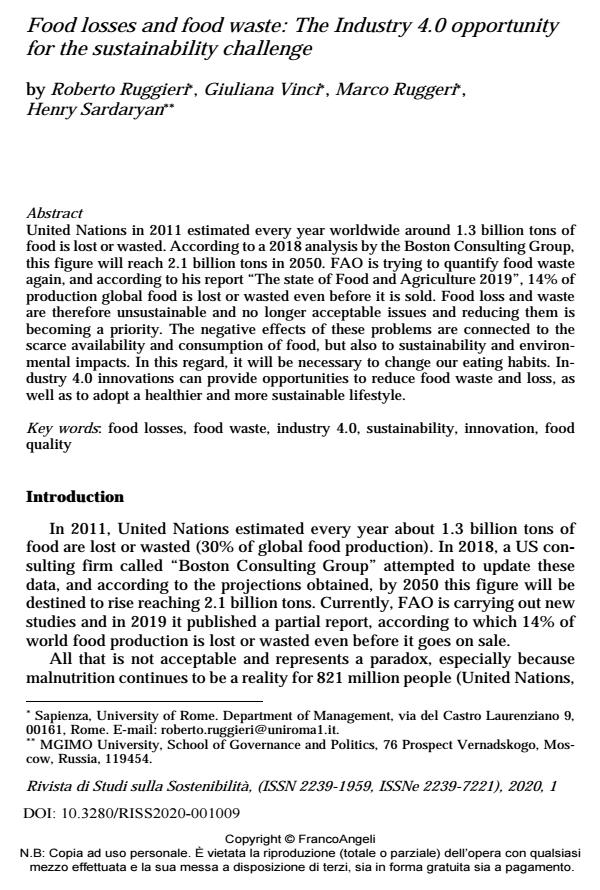Food losses and food waste: The Industry 4.0 opportunity for the sustainability challenge
Journal title RIVISTA DI STUDI SULLA SOSTENIBILITA'
Author/s Roberto Ruggieri, Giuliana Vinci, Marco Ruggeri, Henry Sardaryan
Publishing Year 2020 Issue 2020/1
Language English Pages 19 P. 159-177 File size 771 KB
DOI 10.3280/RISS2020-001009
DOI is like a bar code for intellectual property: to have more infomation
click here
Below, you can see the article first page
If you want to buy this article in PDF format, you can do it, following the instructions to buy download credits

FrancoAngeli is member of Publishers International Linking Association, Inc (PILA), a not-for-profit association which run the CrossRef service enabling links to and from online scholarly content.
United Nations in 2011 estimated every year worldwide around 1.3 billion tons of food is lost or wasted. According to a 2018 analysis by the Boston Consulting Group, this figure will reach 2.1 billion tons in 2050. FAO is trying to quantify food waste again, and according to his report "The state of Food and Agriculture 2019", 14% of production global food is lost or wasted even before it is sold. Food loss and waste are therefore unsustainable and no longer acceptable issues and reduc-ing them is becoming a priority. The negative effects of these problems are con-nected to the scarce availability and consumption of food, but also to sustainabil-ity and environmental impacts. In this regard, it will be necessary to change our eating habits. Industry 4.0 innovations can provide opportunities to reduce food waste and loss, as well as to adopt a healthier and more sustainable lifestyle.
Keywords: Food losses, food waste, industry 4.0, sustainability, innovation, food quality
- Food sustainability 4.0: harnessing fourth industrial revolution technologies for sustainable food systems Abdo Hassoun, in Discover Food 171/2025
DOI: 10.1007/s44187-025-00461-z - The Environmental, Economic and Social Impact of Industry 4.0 in the Food Sector: a Descriptive Literature Review. Roberta Stefanini, Giuseppe Vignali, in IFAC-PapersOnLine /2022 pp.1497
DOI: 10.1016/j.ifacol.2022.09.602 - Food Industry 4.0 Barbara Bigliardi, Serena Filippelli, Benedetta Pini, Eva Falch, Cennet Pelin Boyaci Gunduz, Abdo Hassoun, pp.15 (ISBN:9780443155161)
- Smart waste management 4.0: The transition from a systematic review to an integrated framework Devika Kannan, Shakiba Khademolqorani, Nassibeh Janatyan, Somaieh Alavi, in Waste Management /2024 pp.1
DOI: 10.1016/j.wasman.2023.08.041 - An Evaluation of Industry 4.0 Capabilities for Sustainable Innovation in Food Sector Lakshminarayan Balaji, Elmira Naghi Ganji, Satya Shah, in International Journal of Applied Sciences & Development 27/2024 pp.299
DOI: 10.37394/232029.2024.3.27
Roberto Ruggieri, Giuliana Vinci, Marco Ruggeri, Henry Sardaryan, Food losses and food waste: The Industry 4.0 opportunity for the sustainability challenge in "RIVISTA DI STUDI SULLA SOSTENIBILITA'" 1/2020, pp 159-177, DOI: 10.3280/RISS2020-001009